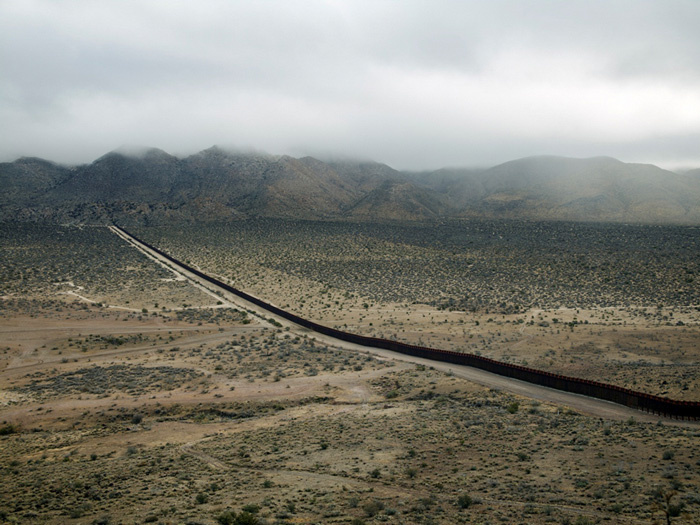Foreword
Richard Misrach and Guillermo Galindo bring a humanitarian perspective to the heated political debates that surround the subject of immigration today. As artists, they encourage our innately human capacity for empathy and understanding, whatever our politics or stance on immigration reform, homeland security, or continental economics may be. This exhibition underscores the necessity—indeed the humane urgency—of civil dialogue about the tough issues that can divide us most drastically as a community and as a nation, particularly in this election year.
With Border Cantos, the San Jose Museum of Art extends its role as a museum in the twenty-first century, in the belief that a cultural institution can be a shared space for civic engagement, with art as the vehicle—a place for communal conversations as well as personal aesthetic pleasures. As an exhibition, Border Cantos is more than a platform for the artists’ poignant and impassioned creative work: it is a forum wherein to consider the commonalities, ambiguities, and contradictions—the disturbing realities—found beyond the hard edges of political partisanship.
Misrach’s and Galindo’s art first speaks to us viscerally, through our senses, with a stillness and intimacy that are all the more powerful in contrast to the blare of media headlines. In his photographs (some as purposefully big, imposing, and monumental as nineteenth-century academic paintings), Misrach has brought the raking diagonals of the border fence, or a road, or a field of cabbages virtually right up to our feet. With his “found” vanishing points and perspective lines, he casts us into the stage of his landscapes, as if we are about to walk into the vast depths of the desert. Sweeping and expansive, his views fade into a far-off distance, seemingly never to end. Misrach toys with the divine vistas and romantic, heroic traditions of Western landscape photography, but in the here and now. Within his sublime grandeur lurk the earthbound ills and sad truths that he documents. Misrach leaves the mythic romance of the West twisting in the wind.
In counterpoint, Galindo coaxes us into the microcosm of the migrant’s journey. His assemblages put us squarely down onto the desert floor, amid rusted debris and worn things whose precious legacy of use and touch are inescapable. He has conjured up images of those who are absent: someone who took a sip of water from this bottle or a bite of food from this can; held this memento for consolation; or took one relentless, exhausted step after the next, and then the next, in this tattered shoe. Re-created as instruments and reanimated by a musician’s touch, these objects become the voice of the migrant’s experience. Galindo has sculpted metaphors and shaped sounds that communicate beyond any given language: they are as primal and penetrating as the sigh or cry or groan his compositions may instantly bring to mind.
Misrach’s and Galindo’s immediate subject is immigration along the US-Mexico border, seen up close at human scale and with moral scope. Yet their artworks also echo more broadly and speak as well to the parallel plight of immigrants across the globe and throughout the centuries.
Nearly 244 million people immigrated internationally last year, according to the United Nations: 244 million people left their homes in search of a better or safer life. Many braved perilous, lonely, and circuitous journeys such as those reflected in Border Cantos—journeys that are more likely than not akin to those experienced by a generation of our own families. Immigration is an increasingly urgent worldwide concern. It is a subject of particular relevance in Santa Clara County, where immigration spans the socio-economic spectrum from undocumented service workers to Silicon Valley’s tech professionals. San Jose has been built by waves of immigration that date back to its earliest days as a colonial pueblo. Today, 50 % of the city’s adults over the age of thirty-five were born in a different country.
This exhibition’s title, Border Cantos, points to the many distinct journeys that together shape a collective, national narrative. Each of Misrach’s images and each of Galindo’s assemblage instruments was conceived as a canto, a poignant “song” that is a section within a much longer poem, as in Dante’s classic epic The Divine Comedy or Valmiki’s Ramayana. These cantos similarly tell stories of human struggle, foible, and endless quest, if wordlessly and with restraint. Within this emotional territory, the cantos work alongside the clear mathematical structure of Galindo’s compositions and the serial grids of Misrach’s visual inventories to bring some small order out of the chaos and tragedies of the borderlands. Together, Misrach and Galindo have created a cycle of plaintive “songs” that simultaneously has soulful resonance and makes trenchant social commentary. In many dimensions, in many media, their collaboration returns us to the heart of the massive, ongoing worldwide narrative of immigration today: to the people and the land.
Susan Krane
Oshman Executive Director

